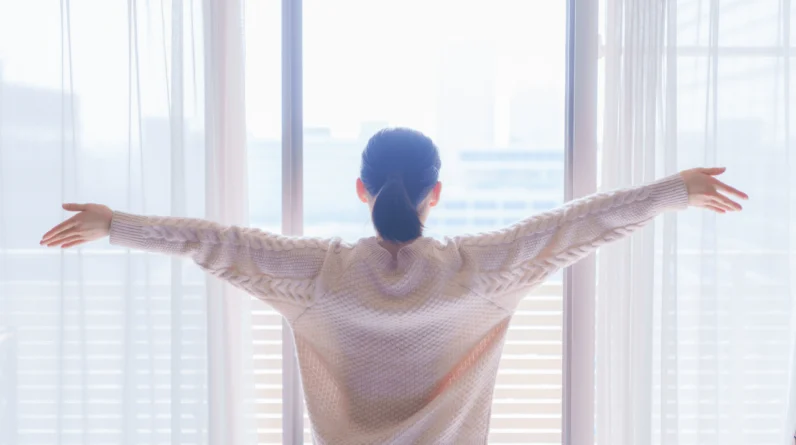
There might be affiliate links on this page, which means we get a small commission of anything you buy. As an Amazon Associate we earn from qualifying purchases. Please do your own research before making any online purchase.
You might be asking yourself – What are visualization techniques?
There is nothing human-made that came into being without forming as an image in the mind. It is basically impossible to create something without imagining it beforehand.
Visual imagery has been being used by psychologists for years, and visualization techniques are one of the ways that help people enhance performance at skill-based activities, create desired emotional states, and achieve life goals.
For example, people who want to learn to become a better basketball player may be able to improve their skills by visualizing shooting baskets in their heads.
A person who wants to improve their ability to play the piano may be able to use one of the visualization techniques below to help their body grow more proficient by using their mind.
Visualization techniques are just one of the ways that we can make our lives better. If you want to learn more about creating a beautiful mind: there is loads more for you to read in our book Declutter Your Mind. A calm mind helps you to focus, and create a life that is fulfilling.
Let’s have a look at how visualization techniques can help you become better at just about anything, just by using your mind’s ability to imagine!
Why
Visualization Techniques Could Work for You
Learning to use
visualization techniques to actively create simulations that can help you
improve the goals that you set for yourself is a viable way to get better at
almost any activity, or realize other life goals as well.
There are two types of mental simulations that you can
create: outcome and process.
An outcome is a
sensory experience that is based on a representation of the outcome you expect,
and a process is the simulation of the steps that get you can use to reach the
final outcome.
Research shows that to get the most benefit from simulations, the best way is to use both types together. Moreover, creating your simulation by using the participant perspective instead of the observer perspective is a key part of the practice.
Visualization techniques have been used by successful people to visualize their goals and visions for a long time.
The practice helps people to create their dream lives with loads of stress and complete confidence. Most of us don’t know we all have this mental power, but almost anyone can use it effectively in their lives.
Making
a Change in Your Mind
Basically, visualization just means using our imagination to pre-live an outcome that is desired. You can increase the focus on your goals and maintain that focus by using visualization techniques.
By reading your goals as images, our brain works to make those images a reality. There is an emotional interpretation and a behavioral response for every image in our subconscious mind.
Here are some benefits that many people get from using
visualization techniques to focus on healthy life goals:
With all that in hand, let’s have a look at some of the ways you can practice using visualization to make your goals manifest in the real world.
Remember, these aren’t chemical formulas, and you may need to be flexible and open to new ideas along the way. Sometimes we have dreams that simply aren’t realistic, and the universe will help us to find what we really need.
#1. Treasure Map Technique
This is a
visualization technique that consists of creating a tangible picture of
something that we want to have. Once you have the idea of what you want, you
can draw it on something physical.
For example, to get
a top score on an upcoming exam, you can start by drawing all of the factors
involved. You may need to create time to study more or find new sources of
information. Whatever the factors you think you will need, make sure to create
a drawing that is as detailed as possible.
The important factor
here is that you are picturing the goals as you draw them
Your mind will be
visualizing the road to success while you are drawing out your map. This
technique requires patience since it takes time to become fully immersed in the
exercise. It will help to be in a quiet place, and do not forget to turn off
any distractions like a television or radio while you make your map to success.
#2. Receptive Visualization
Think of this technique as watching a movie in your mind, but you will be the director. This is a more passive approach than the treasure map, but it can be just as effective.
Start by relaxing with some basic meditation in a quiet place with no outside distractions, lie back, close your eyes, and try to vividly picture the scene you want to manifest in reality.
When you get a clear
image, then you can start adding people and noises in your mind. Keep building
the image slowly until you have a whole picture that feels real.
For example, imagine
you are sitting in a movie theater, the lights are dimming, then the movie
starts. Create the details of the ‘movie’ as much as you can. You can add
clothing, the expression on your face, small body movements, and the
environment that you are in.
Add any sounds you
would hear in the scene, like music, other people talking, or whatever feels
natural to you. Finally, create your feeling which would you be experiencing in
this activity. Try doing this many times, and see where it takes you!
#3. Altered Memory Visualization
Altered Memory Visualization is about changing painful memories to have a more positive outcome.
This method is very useful for resolving memories that involve anger or resentment. You can replay scenes in your mind and replace the angry responses with more calm and controlled ones.
It will take time,
but doing this form of visualization daily can make your life much more
peaceful. Your mind will only remember the scene playing out as you have
recreated it after a while and your painful memories of the actual event will
fade away.
In addition to
bringing peace to your past, this method will also help you to be calmer in
future situations. You are practicing how to be calm, and not act on anger. By
learning from past trauma, we are able to become better people.
#4. Meditate
Meditation is a
great form of passive visualization that can have powerful results and can be
used as the basis of other forms of mind-building exercises.
Visualization
through meditation is the main focus of many forms of self-development. You
should meditate regularly, which will allow you to gain access to your inner
self. The inner place where meditation leads is where you can start to
experience strong visualizations.
Start by making a
plan to set aside time each day to meditate. The experience you gain from this
practice will help your meditation get better. In addition to helping you to
create strong visualizations, this daily meditation will help you to relax.
#5. Picture and Describe
The more details you have in visualization the more real it will seem, and the more it will increase performance as the brain starts to develop creative formations.
You can repeat visual images along with motivational exercises to increase the likelihood that you will take action toward your goal.
For example, you can
think about taking a morning walk, as you want to be more active in your daily
life. By using pictures in your mind of how lovely the early morning hours are,
and how great it feels to take a walk, you will increase the likelihood that
you will begin to take morning walks on a regular basis.
At this point, there
is a natural problem-solving process in your brain, it will work to help you
develop a plan for how to obtain what you want. You might start to think about
how to fit a walk into your morning, or who you can go for a walk with.
As you begin to take
walks in the real-world, the positive experiences that you have will reinforce
the mental images that you created to begin with. Make sure to keep focusing on
the positive aspects of your goals, even after you start to act on them!
#6. Emotional Intensity
Emotion is one of
the most powerful things in our lives, but we generally don’t think much about
using it as a motivational tool.
We know that emotion
is preceded by thought, and when emotion manifests you feel something deeply.
This level of feeling has a tendency to create strong associations, and you can
use this to your benefit. You will have to use things that you fully feel, and
not things that you would like to believe for this method to work.
Create as much detail around a visualization as you can, so that you begin to feel the experience as if it were real at an emotional level.
Once you start to feel it, the emotion will likely lead to action towards your goal. Be careful with putting too much emphasis on things like material gain, as greed is a powerful emotion that isn’t healthy.
One of the strategies that may increase the emotional intensity of visualization is listening to music.
Choose a musical piece which matches the emotional intensity you are cultivating, and then listen to the same piece of music in your daily life. Visualization techniques rely on powerful images, which take time to build up in your mind.
#7. Exposure
To create a detailed
and realistic visual simulation in your mind, it may be necessary to expose
yourself to something in the outside world. It is very difficult for most
people to totally create a scene from their imagination alone, and using
exposure that helps just about anyone to overcome a weak imagination.
For example,
creating a scene of something that you’ve never tried before like scuba diving
may be hard to do. There are a lot of things that go into even a basic scuba
dive, and you will need to have those factors in your mind if you want a
visualization to be effective.
To overcome this,
you can read books, watch videos, or visit a scuba diving school to gain
exposure to the subject you want to experience. By adding real sensory exposure
to your mind on a specific topic, you can use the other techniques on this list
to much greater effect!
Be Open
to New Ideas and Experiences
Visualization allows you to change your beliefs, assumptions, and opinions about yourself. It allows you to harness your 18 billion brain cells and get them all working in a singular and purposeful direction.
Your subconscious
will become engaged in a process that transforms you forever. Over time, as
long as you spend time visualizing your goals and practicing your techniques,
it will be much easier to say focused and make your dreams a reality.
It is also a good
idea to surround yourself with positive people, read uplifting books and listen
to audio programs that flood your mind with positive, life-affirming messages.
No one ever got anywhere by being super negative and looking for problems.
Several studies have supported the benefits of visualization. It is worked together with other therapies, such as treating a variety of conditions from asthma and anxiety to insomnia, and fibromyalgia.
Visualization is one of the several ways you can practice mindfulness to relieve stress and live in the present moment. Take a few minutes to watch the video below to learn about the different morning routine ideas that can help you become more mindful on a daily basis.
Final Thoughts on Visualization Techniques
Using visualization helps people move past obstacles in their life, relax and relieve stress.
The same methods can help people resolve or cope with chronic pain, heal themselves emotionally and physically, as well as accomplish goals such as losing weight or quitting smoking.
Visualization techniques are very helpful and work together with many other forms of mental hygiene. If you want to learn more about how to have a healthy mental state: have a look at our book Declutter Your Mind. There are no easy paths to peace, but with the right tools, you can love the journey as much as the goal.
A daily practice of visualization is important, but it does not mean that we will spend all day thinking about our goals for this technique to work.
Actually, spending too much time in visualization can rob you of something essential, like living in the moment. Do your best to balance your goals with reality, and let visualization techniques help you to build the life you want!
And if you’re looking for quotes and affirmations to complement your visualization habit, check out these blog posts:
Finally, one proven way to improve your happiness and life satisfaction is to focus on goals that truly matter. To get started, check out this FREE printable worksheet and a step-by-step process that will help you set effective SMART goals.

Nicholas Say was born in Ann Arbor, Michigan, and has been interested in global belief systems from a young age. This area of study led him to research many Eastern philosophical systems, including Vedic and Buddhist ideas and practices. Today he thinks that humanity needs to find ways to be happy with being, as opposed to possessing and doing. His views fall roughly in-line with the late philosopher Alan Watts, who he venerates as great teacher.







